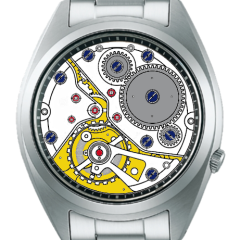An Olma From The 1940S
-
Recently Browsing
- No registered users viewing this page.
-
Topics
-
Posts
-
Bad news: Longines doesn't provide this service free of charge any longer. I have to ask for an extract from the archives or a certificate of authenticity, but I'm afraid it's not worth the cost for this watch. Too bad 🥴
-
Tool for removing or pressing the bezel? Most likely you have to remove the bezel (with a knife) before removing old crystal or inserting a new one. You can press the bezel with the crystal press if you have a suitable die with straight walls or otherwise a die that has enough clearance that it doesn't touch the crystal when pressing the bezel.
-
This will be my first crystal replacement, I have a press, but looking at the watch I wonder if I might need a bezel tool also. Any and all help appreciated.
-
I'm not entirely sure you fully understand what he's doing in the video. For one thing he's giving examples of things like about 16 minutes he talks about opening up the regulator just a little bit. Opening up the regulator slows the watch down to compensate for that he moves the regulator fast and now it's keeping time again but the regulator pins are too far apart. I have an image down below on top of it shows the effect of regulator pins and amplitude. If the regulator pins are farther apart than the example down below then at a higher amplitude timekeeping will be much worse. Why the regulator pins are supposed to be adjusted as an average rule approximately twice the thickness of the mainspring itself. In other words if you look at the spacing it have one half of the hairspring thickness on either side of the hairspring itself. There is like he talks about the video a little bit of adjustment here and there. So in his example where he opened them up it will really dramatically screw up timekeeping based on amplitude. Then when you get to the 20 some minutes like you say he is adjusting the regulator pins closer together to get a more even timekeeping based on amplitude and amplitude changes are caused by going to various positions. Then and the other example of the image down below regulator pins too far apart and they hairspring is not centered and look what that does the timekeeping. So hairspring is supposed to be centered regulator pins are supposed to properly spaced. Then you get reasonably even timekeeping like it shows in the upper image. It's not like we're regulating out positional errors like poising errors because that's something entirely different. In the part number above and in the video both of you left off details. I which version of either of your watches I will just make you's timing specifications for your watch down below may specify how you're supposed to do it other words you wind up the watch fully wound up you wait 10 to 60 minutes in the four positions it should be within 60 seconds. Yes it can be closer but you may not actually get zero. Now let's compare with the 2892 and see where we might have a discrepancy. First off we have a problem of which one is a using did he use the chronometer grade 1 or the top grade or what? None is basically just much tighter timing tolerances. So when he's using an example watch conceivably might be a chronometer grade watch then things are going to be much more perfect than what you're going to see. NH35_TG.pdf ETA 2892-A2 Manufacturing info.pdf
-






Recommended Posts
Join the conversation
You can post now and register later. If you have an account, sign in now to post with your account.
Note: Your post will require moderator approval before it will be visible.